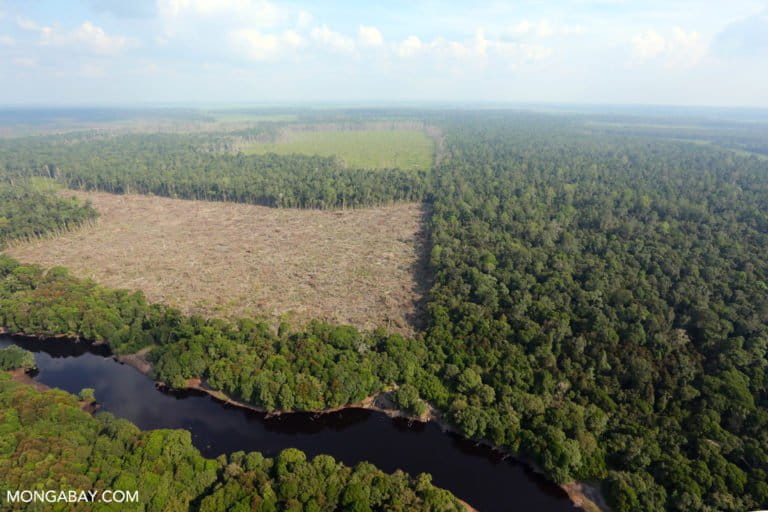Indonesian government says no to reclassifying oil palm estates as forests


- The Indonesian government has rejected a proposal made by a prominent university to reclassify oil palms as a forest crop.
- The proposal was ostensibly meant to resolve the problem of illegal plantations operating inside forest areas, and would have redefined plantations as forests, and new plantings as reforestation.
- The environment ministry says it has no plans to adopt such a plan because it has its own program, the social forestry scheme, to get local communities to switch from illegal oil palm plantations to more sustainable, and profitable, agroforestry systems.
- A decade earlier the government had tried to reclassify oil palms as forest crops, but the effort lasted just a month before it was scrapped in the face of widespread criticism.
JAKARTA — The Indonesian government says it has no plans to reclassify oil palms as a forest crop rather than an agricultural one, following a controversial proposal made by the country’s leading forestry university.
“Based on regulations, historical value, academic studies, public discourse and practices [on the ground], oil palms are clearly not a forest crop and the government hasn’t had a plan yet to revise those regulations,” Agus Justianto, the director-general of sustainable forest management at the environment ministry, said in a press release.
Researchers from the Bogor Institute of Agriculture (IPB) have been pushing to allow palm oil companies to plant in forest areas — something they’re currently prohibited from doing — since 2018. The proposal, led by Yanto Santosa, a professor of forestry at IPB who is controversial within the academic community for his views in support of the palm oil industry, aims to do that by classifying oil palms as a forest crop.
The proposal recently sparked fresh debate as the draft of the proposal circulated in the public.
If it had been accepted by the government, existing plantations counted would have counted as forest, while the establishment of new ones would be considered reforestation.
Agus said the environment ministry recognized that the unfettered and illegal expansion of oil palm plantations into forest areas had created myriad ecological, hydrological, legal and social problems that needed to be resolved.
Among the problems associated with oil palm expansion into forest and its monoculture system are loss of biodiversity, degradation of the quality of forest ecosystems, and increased risk of natural disasters such as landslides.
Agus said the government is now focused on tackling these problems, rather than allowing for more oil palms to be planted inside forest areas.
“Considering that forests have ecological functions that are irreplaceable, and oil palm plantations have already had their own spaces to grow, then right now classifying oil palms as a forest crop or for [forest] rehabilitation purposes is not an option,” he said.
Separately, the environment ministry’s secretary-general, Bambang Hendroyono, told a parliamentary hearing on Feb. 7 that there are no plans to reclassify oil palms.
“We still study the proposal [from ITB], but from the beginning until now, oil palms are not a forest crop,” he said.

Forest areas off-limits to oil palm
Prior to the official rejection of the plan, forestry experts and conservationists had expressed concern that the government might seriously entertain the idea of classifying oil palm plantations as forests.
The proposal was welcomed by a senior government official, Musdalifah Machmud, who serves as the deputy for agriculture to Indonesia’s chief economics minister. And there was a short-lived precedent a decade earlier for such a move.
In 2011, the forestry minister at the time, Zulkifli Hasan, issued a regulation to the same effect, only to revoke it less than a month later, following backlash and criticism that the regulation essentially legalized illegal plantations inside forest areas.
In Indonesia, lands are divided into two main categories: “forest area” and “areas for other purposes,” also known as APL.
When an area is zoned as “forest area,” it’s usually off-limits to any kind of clearing. Some forest areas are earmarked for “productive” activities, which include growing forest crops, selective logging, and agroforestry — but not oil palm cultivation.
However, lack of monitoring and law enforcement has resulted in companies and smallholders establishing oil palm plantations inside forest areas. The government estimates there are 3.37 million hectares (8.33 million acres) of oil palm plantations currently operating illegally inside forest areas.
A fraction of this, 700,000 hectares (1.7 million acres million acres), is farmed by smallholders, who manage on average less than 25 hectares (62 acres), according to Hero Marhaento, a forest conservation researcher from Gadjah Mada University (UGM). The majority of the illegal plantations are large-scale estates managed by companies or businesspeople.
Yanto, the IPB professor who came up with the controversial proposal, said it was aimed at solving the issue of illegal plantations in forest areas. By reclassifying oil palms as a forest crop, he said, all the existing illegal plantations inside forest areas would automatically be legal.
He said the proposed reclassification would also contribute to government’s efforts to rehabilitate degraded lands and forests across the country. There were 14.01 million hectares (34.6 million acres) of severely degraded lands in Indonesia in 2018, according to data from the environment ministry.
“And we’re very slow in rehabilitating them,” Yanto said during a recent online seminar organized by UGM. “In an effort to rehabilitate [these degraded lands], we need a crop that’s liked.”
That crop, he said, is oil palm. The reclassification means that when oil palms are planted in degraded forest area, this will count as reforestation.
Agus, the environment ministry official, said the government doesn’t consider oil palms as a crop that can be used to rehabilitate degraded lands and forests, as stipulated in a 2021 ministerial regulation on land and forest rehabilitation.
UGM’s Hero said planting oil palm as a way to rehabilitate degraded lands would actually damage the environment further. This is because growers might be exempted from their responsibility to restore degraded forests inside their illegal plantations.

Social forestry over illegal plantations
On the issue of illegal plantations, the government is promoting its social forestry scheme, which grants land rights to communities, as a solution.
The program is one of the largest socioenvironmental experiments of its kind, aiming to reallocate 12.7 million hectares (31.4 million acres) of state forest to local communities and given them the legal standing to manage their forests.
Once local communities and farmers receive permits under the social forestry scheme, they’ll be required to adopt a particular agroforestry model called the long-term rehabilitation strategy. This strategy, initiated by UGM, involves planting mixed crops, such as sengon (Albizia chinensis), agarwood, meranti (Shorea spp.) and jengkol (Archidendron pauciflorum), inside illegal oil palm plantations.
These crops are chosen for their potential to restore the ecosystem, since they have deep roots, are easy to cultivate, and have high economic value.
After that, the ecosystem will be rehabilitated to the point that it resembles natural forest in its original state, before it was cleared for monoculture palm plantation.
The social forestry rules prohibit growers from planting new oil palm crops in their existing plantations inside forest areas. Instead, they will be required to plant mixed crops for one harvesting cycle, which lasts for 15 to 25 years, depending on the status of the forest area.
After that, the plantations will be planted with trees and taken over by the state.
Agus said this agroforestry model will solve the issue of illegal plantations while at the same time rehabilitating degraded lands.
Hero, who heads a team at UGM working on the strategy, said agroforestry is also superior to monoculture plantations in terms of ecological benefits.
“What’s most important is the concern over biodiversity [loss] is alleviated much more [by adopting agroforestry] compared to monoculture oil palm plantations,” he said during the same seminar attended by Yanto. “The sequestration of carbon also increases due to an increase in biomass.”
Hero said he’s optimistic the agroforestry model will be welcomed by oil palm farmers, who could benefit from an up to 80% increase in income. He added that growing oil palm mostly benefits large plantation owners, whereas smallholders in forest areas only receive an average of 1 million rupiah ($70) per hectare per month.
“Meanwhile, these farmers mostly own just 1 or 2 hectares,” Hero said, or 2.5 to 5 acres. “That’s very small.”
And a growing number of palm oil mills are refusing to process palm fruit harvested from illegal plantations, amid increased consumer scrutiny of the palm oil industry’s sustainability. This means there’s more incentive for smallholders to join the social forestry program and adopt the agroforestry model, Hero said.
“And what’s more important is that the agroforestry model is seen as an opportunity to increase welfare,” he said. “We don’t know what the palm oil industry is going to be like 20 years into the future. Will it be the same as now? Because a crop boom doesn’t last forever. It could be that there’s a new trend coming soon.”
Banner image: Peatlands deforestation for oil palm in Sumatra, Indonesia. Image by Rhett A. Butler / Mongabay.
Source
Language of the news reported
Related content:
Copyright © Source (mentioned above). All rights reserved. The Land Portal distributes materials without the copyright owner’s permission based on the “fair use” doctrine of copyright, meaning that we post news articles for non-commercial, informative purposes. If you are the owner of the article or report and would like it to be removed, please contact us at hello@landportal.info and we will remove the posting immediately.
Various news items related to land governance are posted on the Land Portal every day by the Land Portal users, from various sources, such as news organizations and other institutions and individuals, representing a diversity of positions on every topic. The copyright lies with the source of the article; the Land Portal Foundation does not have the legal right to edit or correct the article, nor does the Foundation endorse its content. To make corrections or ask for permission to republish or other authorized use of this material, please contact the copyright holder.
